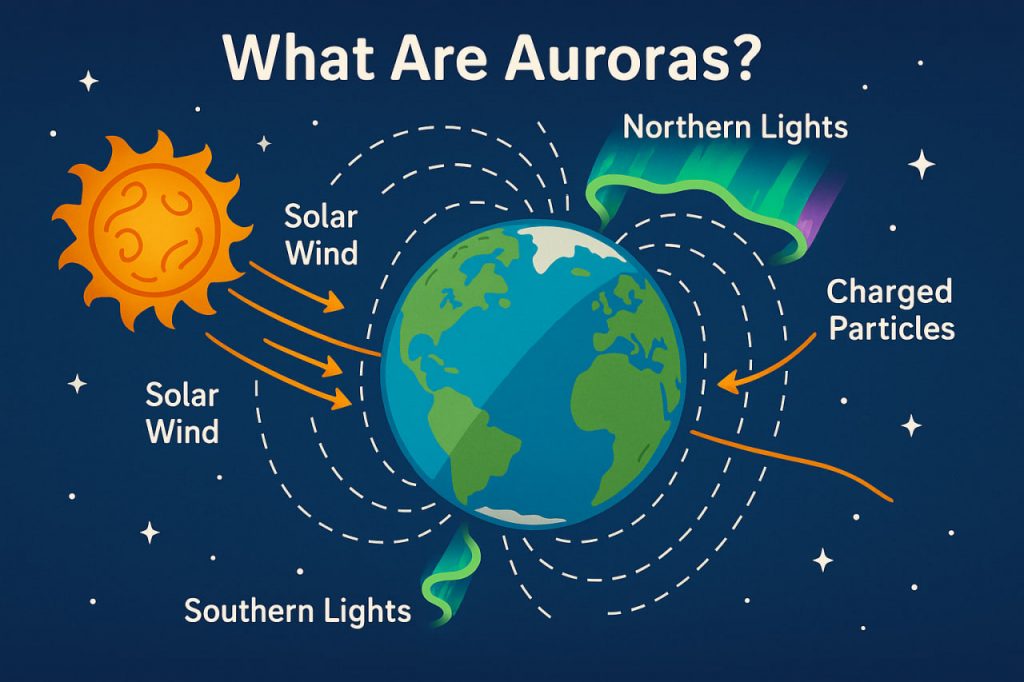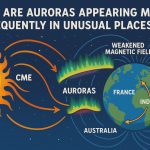Polar auroras, also known as the Northern Lights (Aurora Borealis) and Southern Lights (Aurora Australis), are stunning light displays in the night sky near the poles. These natural phenomena appear as glowing curtains, arcs, or spirals of green, red, blue, or violet light. But beyond their beauty lies a fascinating interaction between the Sun and the Earth’s magnetic field.
What Causes Auroras?
Auroras are caused by charged particles from the Sun interacting with Earth’s magnetic field and atmosphere.
Here’s how it works:
- The Sun emits solar wind—a stream of charged particles (mostly electrons and protons).
- When these particles reach Earth, most are deflected by the magnetosphere, our planet’s protective magnetic shield.
- Near the magnetic poles, the field is weaker, and some particles enter the upper atmosphere.
- These particles collide with gas molecules (like oxygen and nitrogen), exciting them.
- As the gases return to their normal state, they release energy as visible light—the aurora.
Why Auroras Are Seen Near the Poles
The magnetic field channels solar particles toward the poles, which is why auroras are mostly visible in:
- The Arctic (northern regions like Alaska, Canada, Scandinavia, and Siberia)
- The Antarctic (southern polar regions)
Colors of the Auroras
Different gases and altitudes create different colors:
- Green: Most common; caused by oxygen about 100–300 km above Earth
- Red: High-altitude oxygen (>300 km)
- Blue and purple: Caused by nitrogen
- Pink and white: A mix of colors or intense solar activity
When and Where to See Auroras
- Best during the equinox months (March and September)
- Visible on dark, clear nights near the poles
- Stronger during periods of high solar activity (solar storms or sunspot cycles)
Sometimes, during intense solar storms, auroras can be seen much farther from the poles.
Scientific Importance
Auroras provide insight into:
- Earth’s magnetic field
- The behavior of the solar wind
- Space weather and its effects on satellites, radio, and GPS
They’re not only beautiful—they’re useful for studying the space environment.
Myths and Cultural Significance
Throughout history, auroras have inspired legends and myths:
- Vikings believed they were reflections from the shields of warrior maidens.
- Indigenous peoples saw them as ancestral spirits or omens.
- Today, they remain a powerful symbol of the mysteries of nature.
Conclusion
Auroras are brilliant displays of natural light caused by the interaction between solar particles and Earth’s atmosphere. These polar lights are not only a visual wonder but also a reminder of our planet’s connection to the Sun and space beyond. Whether you’re watching from the Arctic or just seeing photos, auroras reveal the beauty of cosmic forces at play.
Glossary
- Solar wind: A stream of charged particles released from the Sun
- Magnetosphere: Earth’s magnetic field that protects us from solar radiation
- Atmosphere: The layer of gases surrounding Earth
- Collision: When particles strike each other, transferring energy
- Excitation: A state when atoms absorb energy before releasing it as light


